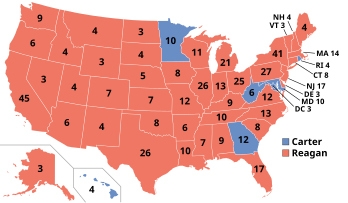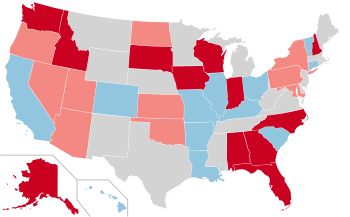This article needs additional citations for verification .(March 2015) |
| ← 1978 1979 1980 1981 1982 → Presidential election year | |
| Election day | November 4 |
|---|---|
| Incumbent president | Jimmy Carter (Democratic) |
| Next Congress | 97th |
| Presidential election | |
| Partisan control | Republican gain |
| Popular vote margin | Republican +9.7% |
| Electoral vote | |
| Ronald Reagan (R) | 489 |
| Jimmy Carter (D) | 49 |
 | |
| 1980 presidential election results. Red denotes states won by Reagan, blue denotes states won by Carter. Numbers indicate the electoral votes won by each candidate. | |
| Senate elections | |
| Overall control | Republican gain |
| Seats contested | 34 of 100 seats |
| Net seat change | Republican +12 |
 | |
| 1980 Senate results Democratic hold Contents
| |
| House elections | |
| Overall control | Democratic hold |
| Seats contested | All 435 voting members |
| Popular vote margin | Democratic +2.6% |
| Net seat change | Republican +34 |
 | |
| 1980 House of Representatives results Democratic gain Democratic hold | |
| Gubernatorial elections | |
| Seats contested | 15 (13 states, 2 territories) |
| Net seat change | Republican +4 |
 | |
| 1980 gubernatorial election results Territorial races not shown Democratic hold | |
Elections were held on Tuesday, November 4, 1980. Republican presidential nominee Ronald Reagan defeated incumbent Democratic President Jimmy Carter in a landslide. Republicans picked up seats in both chambers of Congress and won control of the Senate, though Democrats retained a majority in the House of Representatives. The election is sometimes referred to as part of the "Reagan Revolution", [1] a conservative realignment in U.S. politics and marked the start of the Reagan Era.
Reagan defeated George H. W. Bush and other candidates in the 1980 Republican presidential primaries, while Carter fended off a challenge from Senator Ted Kennedy in the 1980 Democratic primaries. In the general election, Reagan won 489 of 538 electoral votes and 50.7 percent of the popular vote, while Carter won 41.0 percent of the popular vote and independent candidate John B. Anderson took 6.6 percent of the vote.
Republicans picked up twelve Senate seats to take control of a chamber of Congress for the first time since the 1954 elections. They picked up 34 seats in the House, but Democrats retained a comfortable majority in that chamber. In the gubernatorial elections, Republicans won a net gain of four seats. This was the first presidential election since 1964 that the winning candidate had coattails in the House and Senate. This was the last election until 2020 when a chamber of Congress changed hands in a presidential election, and the first to do so since 1952. The 97th Congress was also the first since the 72nd Congress after the 1930 elections to have each house controlled by a different party.
This marks the most recent of four occasions where a newly elected president entered office with a divided legislature, which also occurred in 1860, 1876, and 1884. 1876 is the only other occasion where the president's party held the Senate, but not the House. A divided Congress also occurred after the 1984 and 2012 elections.